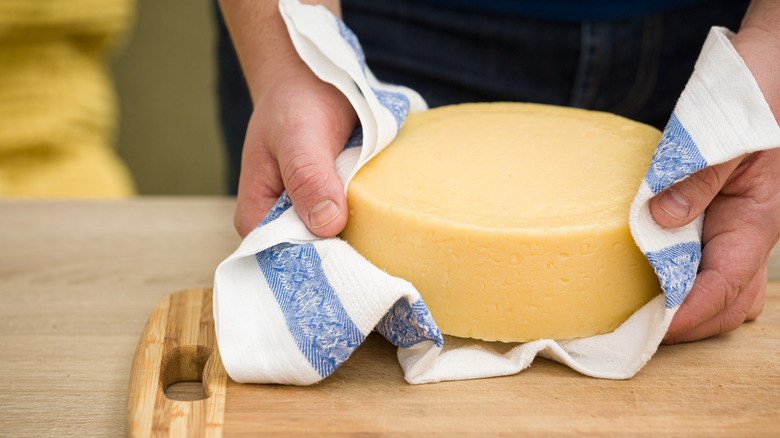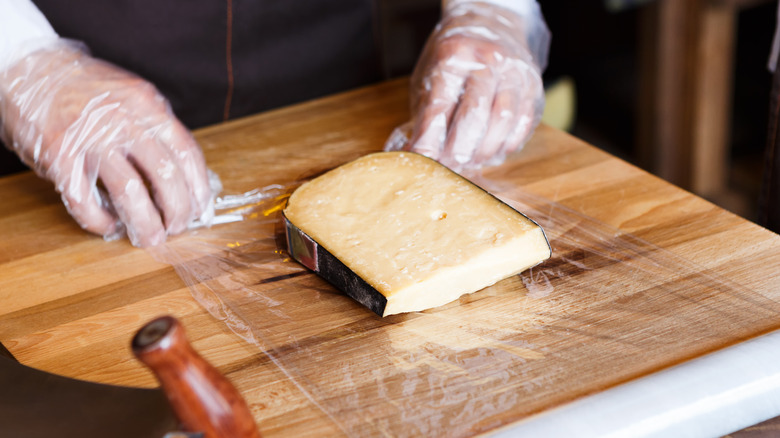The Biggest Mistake You're Making When Storing Cheese
Carving cubes and slices of cheese a day ahead of time is a valuable way to eliminate some stress if you're preparing some snacks for a get-together. And storing the prepped product is as simple as placing it in an airtight container and tossing it in the fridge ... or so you would think. When making an extravagant charcuterie board or a straightforward cheese and cracker platter for movie night, your pre-cut cheese should be respected like the star of the dish it is and sealing it in an airtight container simply won't cut it.
According to the owner and president of The Cheese Store of Beverly Hills Dominick DiBartolomeo, this is actually one of the biggest mistakes you can make when storing your prized hunks of dairy. A quick look around his shop — found here on Instagram — showcases his love for the product, and his adoration is matched only by his adept knowledge of it. This expert cheese connoisseur says that airtight containers aren't the best choice for storing cheese in the fridge, "Tupperware and Ziplock bags create too much moisture and will exacerbate the growth of mold much quicker."
The last thing you want to see when you open the fridge is mold clinging to the side of your cheese blocks, wedges, or slices. Keeping them from going unpleasantly colorful requires wrapping cheese tightly with plastic. DiBartolomeo adds, "I am not opposed to Tupperware or Ziplock bags so long as they are a secondary means of storage and used after the cheeses have been wrapped in Saran Wrap."
Putting your cheese away
While some say that wrapping cheese in plastic can lessen its quality, DiBartolomeo explains that it's his go-to method of storage. Not only is it how he makes sure his products are prime in-store, but he also uses this technique when storing cheese at home. "I really think it's ideal for the prevention of mold growing too quickly and to prevent the cheeses from drying out" he says. Another approach DiBartolomeo recommends is adding an additional layer of butcher paper around the wrapped cheese to further protect its integrity. Butcher paper is a thick, moisture-resistant kraft paper generally used to wrap meat. DiBartolomeo says that while it's not entirely necessary, it does help keep the cheese at its highest quality.
It's also beneficial to place your cheese in the right area of the fridge. Modern refrigerators have a dedicated cheese drawer that maintains steady temperature and humidity levels. Ideally, this is where you want to store cheese. If your fridge is slightly older and doesn't have a cheese drawer, the vegetable crisper — typically the drawer used to store produce correctly — is the next best thing, as it also keeps humidity and temperature levels more consistent.
Getting it back out
Speaking of temperature, whatever cheese you use to elevate your charcuterie board, it's important to let it warm up properly. If it's pulled directly out of the fridge and served cold, it can be rubbery or crumbly, and people won't be able to experience the full flavor it has to offer. DiBartolomeo has a few tricks you'll want to remember when warming it up before serving.
According to our expert, the ideal temperature for cheese consumption is 68 to 72 degrees Fahrenheit. How long it takes to warm up depends on what variety you're working with. A soft camembert cheese doesn't take long to reach optimal temperature and should be ready in about 30 minutes, but harder assortments like aged gouda will take closer to an hour. Semi-soft cheeses like mozzarella (one of the best cheeses to add to a summer pasta salad) take some time in between to arrive at an ideal temperature.
It is also a wise decision to cover your cheese as it rises in temperature. Wax paper or a clean cloth are fitting choices because they will reduce exposure to air and humidity that result in your dairy sweating, DiBartolomeo says. While plastic wrap is crucial for refrigeration, it's something to avoid when warming because it will also trap moisture and cause the cheese to sweat — not an appealing look for your beautiful fromage spread.


